Jim Marshall: The Man Behind the “Wall of Sound”
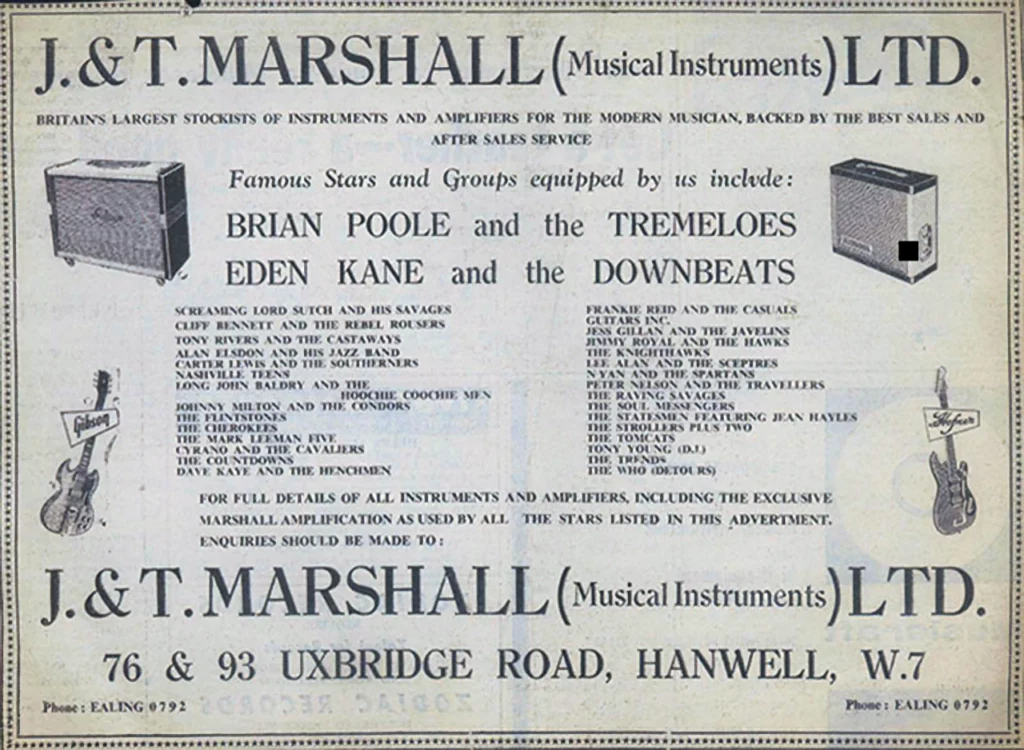
Jim Marshall, known as “The Father of Loud”, began his career as a singer and drummer, later becoming a drum teacher. Jim also opened a music shop in London, which became a meeting point for musicians of the time. Noticing the growing demand for high-quality, powerful amplifiers, Marshall and a team of engineers began designing and building amplifiers, resulting in the first Marshall amplifiers.
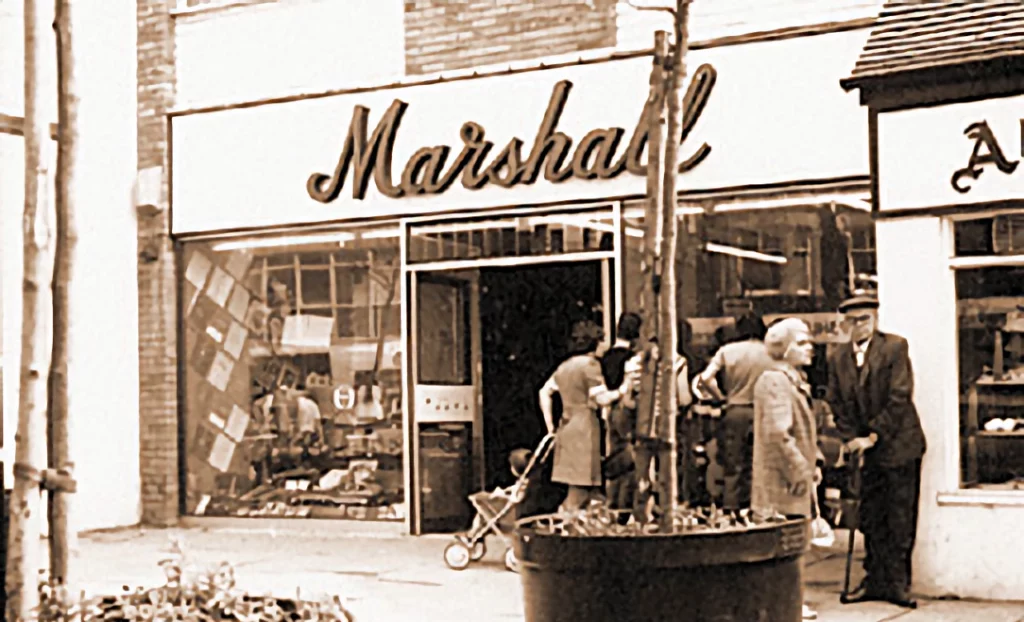
On the real location of the first store, I refer you to this interesting page where we discuss the real first location.
The Evolution of Marshall Amplifiers
JTM45 (1962)
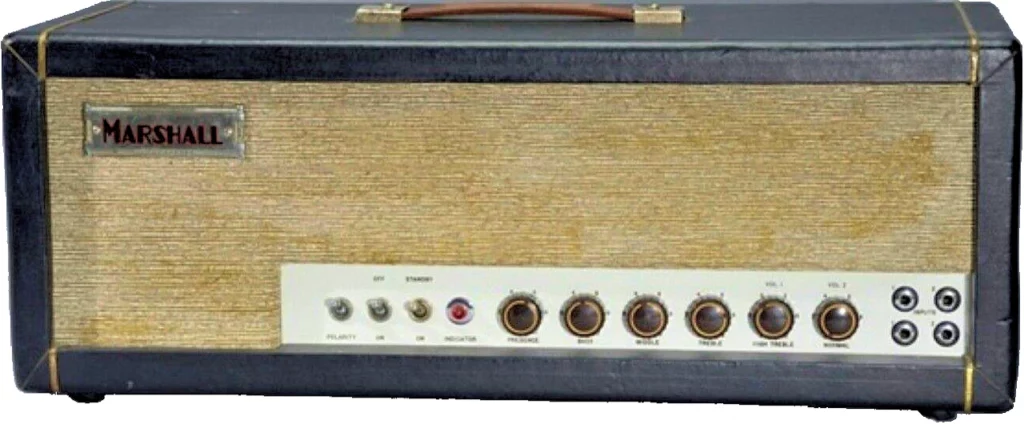
The JTM45 is an electric guitar amplifier produced by Marshall amplifiers. The original unit was first produced in 1962 and gained its fame due to its warm and powerful distortion, which became central to the sound of British rock during the 1960s and 1970s. Below are some of the key technical features of the original 1962 JTM45:
General features:
- Model: Marshall JTM45
- Year of Production: 1962
- Type: Tube Amplifier
- Usage: Ideal for electric guitars
Electronic Specifications:
- Tubes: Usually, 3 x ECC83 (12AX7) in the preamp and 2 x KT66 in the power section, and a GZ34 (or 5AR4) as rectifier.
- Output Power: About 30-35 watts
- Inputs: 4 (2 High, 2 Low)
- Channels: 2 (Normal and High Treble), non-switchable by foot pedal
- Controls: Presence, Bass, Middle, Treble, Volume Normal, Volume High, Treble
Physical Characteristics:
- Cabinet: Headboard (combo versions also exist)
- Weight: Varies by configuration
- Colour: Originally creamy white with a golden front grille, it later turned black
- Materials: Rolex, plexiglass (for the first models with the “plexi logo”)
Sound:
- Sound: Warm, powerful, with beautiful natural distortion when the volume is pushed
- Iconic Use: Widely used in blues and rock, especially in the early years of Jimi Hendrix and Eric Clapton
Variants:
Over the years, several variants of the JTM45 have been created, also in combo formats and with some variations in circuitry or components. Some of these variations have been created to meet the needs of specific musicians or genres of music.
Note:
- It is important to note that specifications may vary slightly between different units and versions of the JTM45, due to minor manufacturing changes or component upgrades over time.
1962 Bluesbreaker Combo
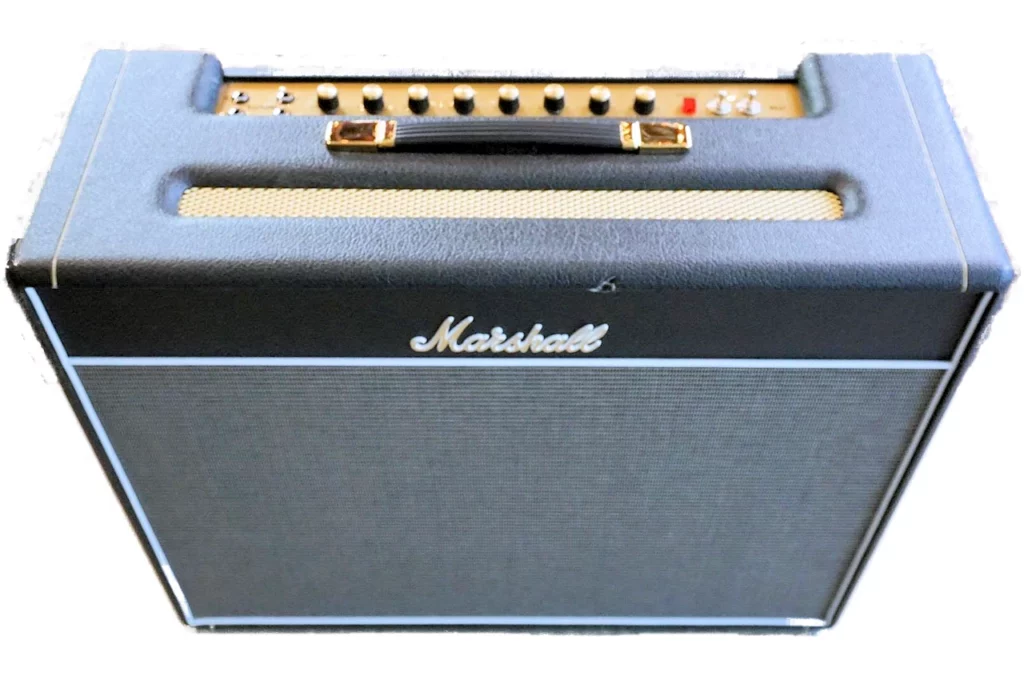
The Marshall 1962 Bluesbreaker Combo is an iconic amp that got its nickname “Bluesbreaker” when Eric Clapton used it with John Mayall & the Bluesbreakers on their 1966 album. It is known for its warm and rich sound, which is particularly loved by bluesmen.
General features:
- Model: Marshall 1962 Bluesbreaker
- Production Period: Originals produced in the 60s. Several reissues were produced in the following years
- Type: Tube Amplifier
Electronic Specifications:
- Tubes: 3 x ECC83 (12AX7) in the preamp, 2 x KT66 in the power section, and 1 x GZ34 rectifier
- Power Output: About 30 watts
- Inputs: 4 (2 High sensitivity, 2 Low sensitivity)
- Channels: 2 (Normal e High Treble)
- Controls: Presence, Bass, Middle, Treble, Volume for each channel
- Loudspeakers: 2 x 12″ Celestion G12M Greenback
Physical Characteristics:
- Type: Combo
- Weight: Approx. 30 kg
- Dimensions: 740mm x 610mm x 230mm
- Colour: Blue/black tolex upholstery and grey front grille
Sound Features:
- Sound: Warm, with rich mids and a creamy overdrive when pushed
- Genres: Blues, Classic Rock
Note:
- The original used by Eric Clapton had Celestion alnico speakers, which differed from the Greenbacks used in reissues.
- The Marshall Bluesbreaker is often praised for its “creamy” sound and natural overdrive, and its tone is often associated with the “British Blues Sound” of the ’60s.
- Despite being relatively less powerful than other Marshall amps, the Bluesbreaker is capable of delivering a rather loud sound and a much-loved overdrive.
The Marshall 1962 Bluesbreaker has retained its popularity and resonance over the years, both in the original models from the 60s and in the various reissues and modernized versions. For those looking to recreate those classic blues and rock tones of the ’60s, the Bluesbreaker remains a popular choice.
Plexi 1959 (1965-1981)
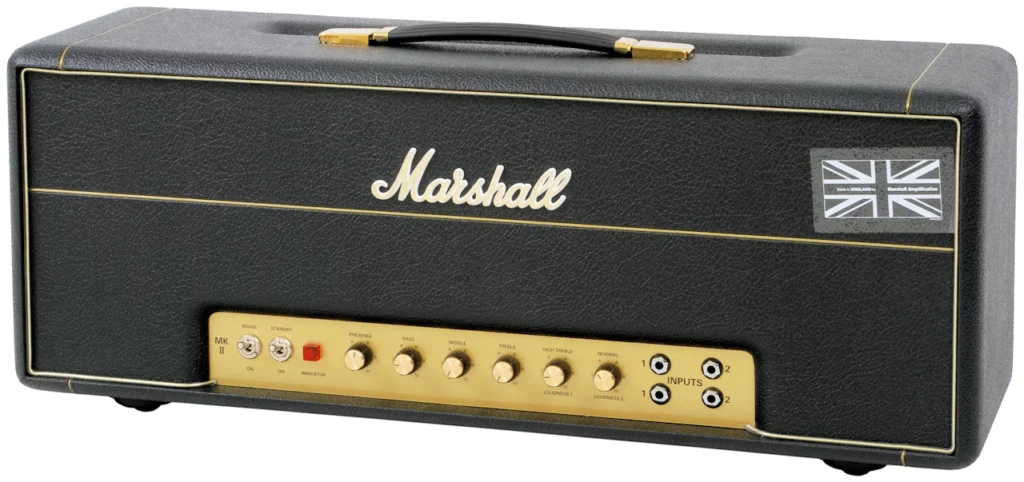
The Marshall 1959 model, commonly known as “Plexi” because of its plexiglass front panel used in models produced in the 60s, is one of the most iconic and desired guitar amps ever. This tube amp defined the sound of rock, having been used by legends such as Jimi Hendrix, Eric Clapton, and Jimmy Page.
General features:
- Model: Marshall 1959 Super Lead Plexi
- Initial Year of Production: 1965 (initial models)
- Type: Tube Amplifier
Electronic Specifications:
- Tubes: Generally, 4 x ECC83 (12AX7) in the preamp and 4 x EL34 in the power section.
- Power Output: 100 watts
- Inputs: 4 (2 for the “High Treble” channel and 2 for the “Normal” channel), often used creatively by guitarists through the “jumpering technique”
- Channels: 2 (High Treble and Normal), non-switchable by foot pedal
- Front Controls: Presence, Bass, Middle, Treble, Volume 1 (High Treble), Volume 2 (Normal)
- Configuration: Head
Physical Characteristics:
- Cabinet: Amplifier head, often coupled with a 4×12 speaker
- Weight: Depending on version and format, weight may vary
- Color: Gold front panel with Marshall logo and black tolex for the cabinet
- Materials: Plexiglass front panel in the original models of the 60s
Sound:
- Sonic Features: Powerful and dynamic clean, natural and organic overdrive when pushing volume, rich sustain and dense harmonics
- Iconic Use: Wide use in classic rock and hard rock, ideal for powerful leads and punchy rhythms
Variants and Re-editions:
There have been numerous reissues and variants of the 1959 Plexi over the years, some with minor modifications and others with specific modern additions (such as effect loops or additional controls).
Note:
- The creative use of inputs and settings can greatly affect the sonic character of the Plexi, making it incredibly versatile despite the apparent simplicity of the control panel.
- The Plexi 1959 is known for its extremely loud sound and its ability to deliver natural, warm distortion when the volume is turned up.
Marshall Super Lead (1969-1981)
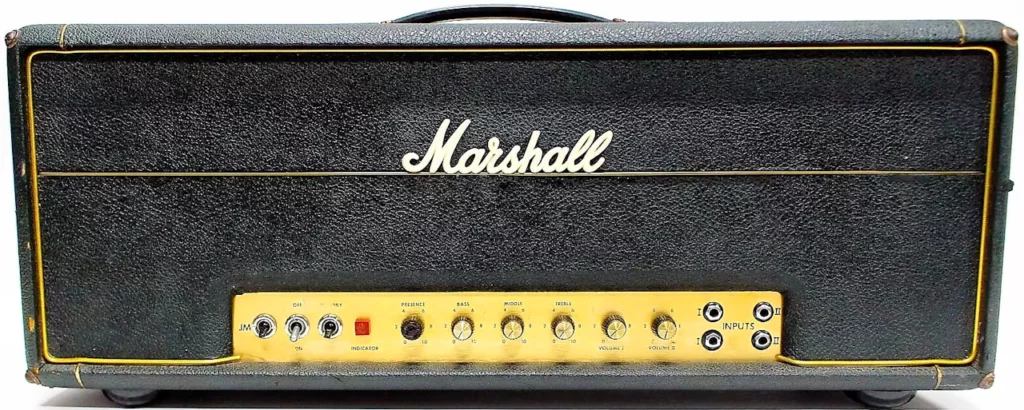
The “Marshall Super Lead” primarily refers to the 1959 model, an iconic amp that had a significant impact on the sound of rock and roll. In some contexts, “Super Lead” could also refer to an entire line of amplifiers, but here we will focus on 1959 for its iconicity and recognizability.
General features:
- Model: Marshall 1959 Super Lead
- Production: Started in 1965
- Type: Tube amplifier
Electronic Specifications:
- Tubes: 4 x ECC83 (or 12AX7) in the preamp and 4 x EL34 in the power section.
- Power Output: 100 watt
- Inputs: 4 (2 for the “High Treble” channel and 2 for the “Normal” channel)
- Channels: 2 (High Treble and Normal), not footswitchable
- Controls: Presence, Bass, Middle, Treble, Volume 1 (High Treble), Volume 2 (Normal)
Physical Characteristics:
- Cabinet: Head
- Weight: Variable based on versions and productions
- Aesthetics: Black cabinet with golden metal front panel in the most iconic and original models equipped with plexiglass
Sound Characteristics:
- Sound: Notable for its clean, bright sound, and warm, dynamic overdrive when pushed
- Genres: Extremely popular in classic rock, hard rock, and metal
Note:
- Guitarists often use the “jumpering” technique, connecting the inputs together with a short cable, to mix the sounds of the Normal and High Treble channels.
- The amplifier has no reverb or built-in effects and has a powerful, penetrating sound.
- The “Plexi” has undergone various modifications and versions over the years, with slight variations in specifications and materials used.
- It has been used by legendary guitarists such as Jimi Hendrix, Eric Clapton, and Jimmy Page.
“Marshall Super Lead” amplifiers are known for their robustness, powerful sound, and ability to create desirable distortion tones when playing at high volumes. Over the years, Marshall has produced several re-editions of the 1959 Super Lead to meet the demand of guitarists looking to capture that classic tone, with some modern modifications for added versatility and practicality.
JCM800 (1981-1989)
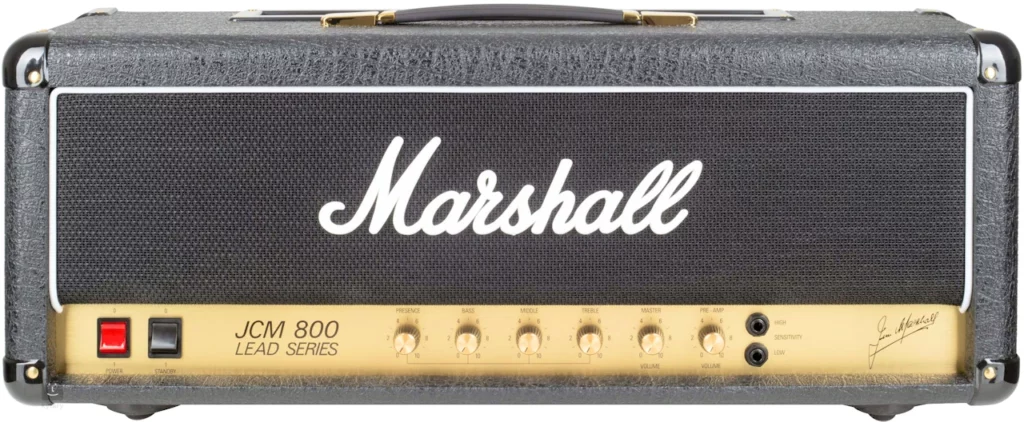
The Marshall JCM800, first introduced in the 80s, has become one of the most recognizable and emblematic amplifiers in rock history. It is known for its powerful sound and its ability to provide clear, sharp distortion that has become crucial for genres such as hard rock and heavy metal. Below is an overview of the technical characteristics of a typical JCM800, specifically the 2203 model, which is a very representative model of the series.
General features:
- Model: Marshall JCM800 2203
- Production Period: Introduced in the early 1980s
- Type: Tube amplifier
Electronic Specifications:
- Tubes: 3 x ECC83 (or 12AX7) in the preamp and 4 x EL34 in the power section
- Output Power: 100 watts
- Inputs: 2 (High e Low Sensitivity)
- Channels: 1
- Controls: Presence, Bass, Middle, Treble, Master Volume, Pre-Amp Volume
- Impedance: 4/8/16 Ohm with multiple outputs
Physical Characteristics:
- Cabinet: Head
- Weight: Approx. 20.5 kg
- Dimensions: Approximately 740mm x 310mm x 210mm
- Color: Black with gold corners and gold front panel
Sound Features:
- Sound: Clear, sharp and powerful distortion. Brilliant cleans and aggressive overdrive
- Genres: Optimized for hard rock, heavy metal, punk, and other energetic genres
Note:
- The JCM800 was one of the first amplifiers to offer Master Volume control, allowing guitarists to achieve distorted sounds without the need to turn the volume up too highly.
- This amp has been used by a wide variety of artists from different genres, including Slash (Guns N’ Roses), Kerry King (Slayer), and Zakk Wylde.
- The JCM800 is available in several configurations, including combo models and heads with different speaker options.
The JCM800 series includes a variety of models with slight variations in specifications and controls
JCM900 (1990-1999)
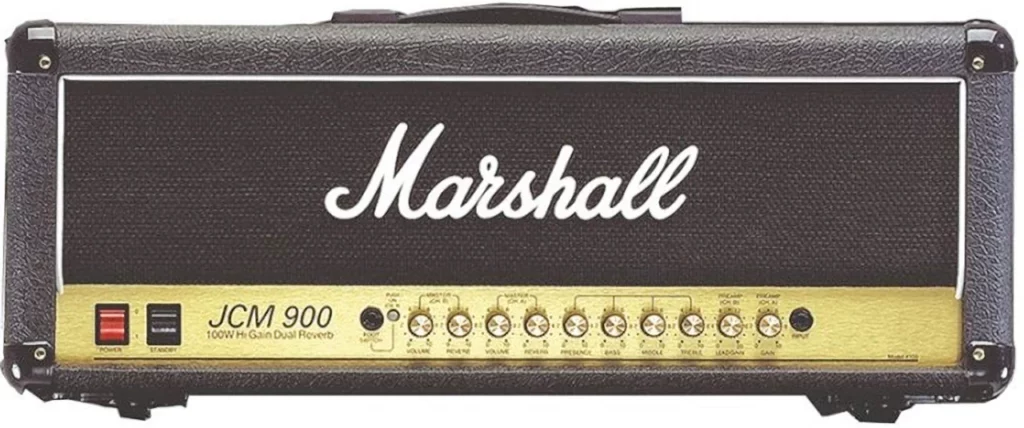
The Marshall JCM900 is another iconic amp in the history of rock and metal music. Introduced in the 90s as a successor to the famous JCM800, the JCM900 was known for offering more gain and versatility, while retaining the classic Marshall sound. Below are some technical features of the JCM900 model. It’s important to note that there are different versions of the JCM900, so specifications may vary slightly between models. In this overview, we will focus on the 4100 model, one of the most common in the JCM900 series.
General features:
- Model: Marshall JCM900 (Model 4100)
- Production Period: Started in the early 1990s
- Type: Tube amplifier
Electronic Specifications:
- Tubes: 3 x ECC83 in the preamp and 2 x 5881 in the power section
- Output Power: 100 watts (there is also a 50 watt version)
- Inputs: 1
- Channels: 2 (Channel A & Channel B)
- Controls: Presence, Bass, Middle, Treble, Reverb (per channel), Volume (per channel), Gain (per channel), Lead Master, and a channel selector
- Effects: Reverb
Physical Characteristics:
- Cabinet: Head (combo versions also exist)
- Weight: Approximately 20 kg for the head
- Dimensions: Vary depending on model (head or combo)
- Color: Black with gold front panel
Sound Features:
- Sound: Versatile with the ability to achieve bright clean sounds and aggressive, edgy distortion
- Genres: Rock, Metal, Punk, Grunge, and others
Note:
- The JCM900 was popular among rock and metal guitarists of the 1990s and 2000s and continues to be used by many artists.
- The amp offers a versatile range of sounds, from clean to crunch to high gain, making it suitable for a variety of musical styles.
- The model has undergone several revisions and updates over the years, with different variants offering slightly different specifications (e.g. SL-X models).
The Marshall JCM900 is appreciated for its combination of classic Marshall tones and modern versatility.
DSL Series
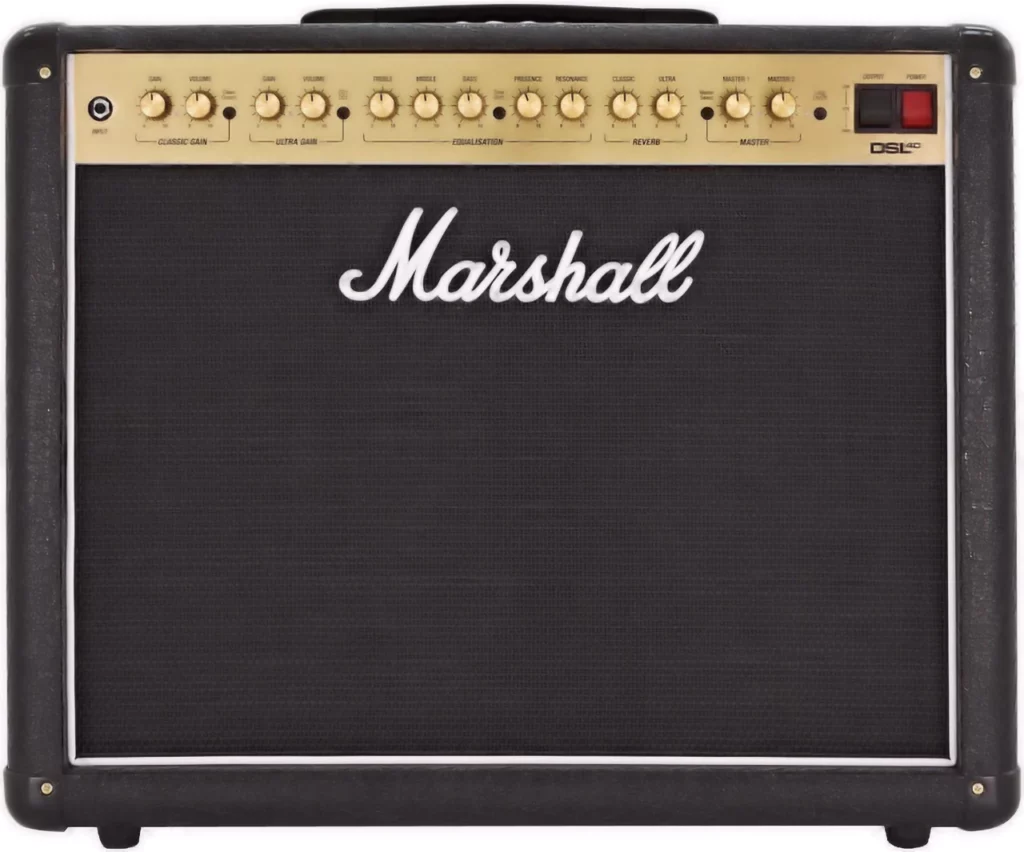
The Marshall amplifiers DSL (Dual Super Lead) series is known for its versatility and ability to generate both clean sounds and a range of distorted tones. The DSL series was launched in the 90s and has seen several iterations since then, each with its own unique specifications and features. In general, DSL amplifiers offer a wide range of tones that are suitable for a variety of musical genres.
The Marshall DSL40, a popular combo model in the series, is under consideration as an example of the DSL series’ features. Note that there are many different versions of the DSL series, so specifications may vary depending on the specific model.
General features:
- Model: Marshall DSL40
- Production Period: Various iterations since the late 90’s
- Type: Tube Amplifier
Electronic Specifications:
- Tubes: 4 x ECC83 (12AX7) in the preamp, 2 x EL34 in the power section
- Output Power: 40 watts, with option to reduce power to 20 watts
- Inputs: 1
- Channels: 2 (Classic Gain and Ultra Gain), each with two modes
- Controls: Volume and Gain for each channel, Reverb, Treble, Middle, Bass, Presence and Resonance, and a Tonal Shift tone switch
- Effects Loop: Yes
Physical Characteristics:
- Type: Combo (also available as a head)
- Speakers: 1 x 12″
- Weight: Approx. 22.9 kg
- Dimensions: Approx. 620mm x 490mm x 252mm
- Color: Black with gold front grille
Sound Features:
- Sound: Versatile, capable of producing clean, crunch and high-gain tones
- Genres: Suitable for a variety of genres, from rock to metal to blues
Note:
- The DSL series is appreciated for its flexibility and ability to adapt to different musical situations, both live and in the studio.
- DSL amps are known for maintaining a classic Marshall character in clean and crunch tones, while also offering more aggressive distortion options when needed.
- The DSL series has undergone several revisions over the years, so there are several variants available on the market with slightly different specifications.
JVM Series (2007-present)
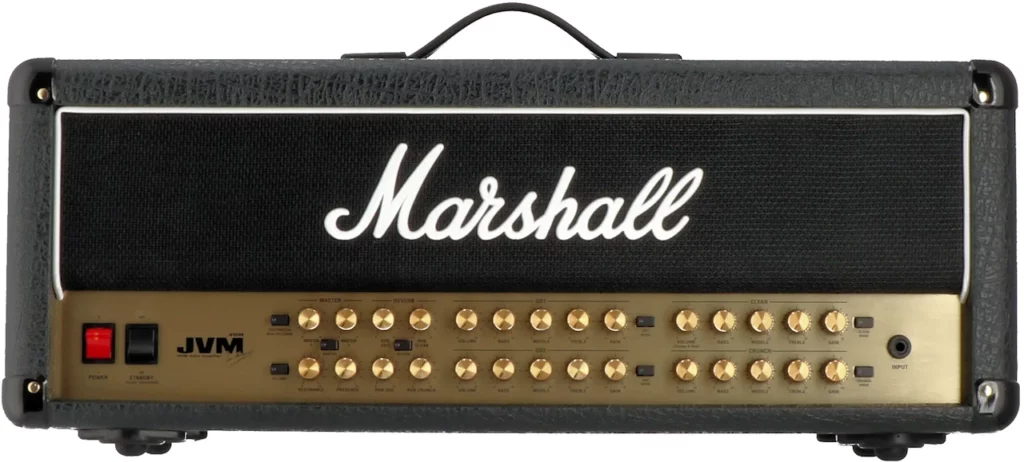
The Marshall JVM (Java Virtual Machine) series of amplifiers is renowned for its versatility and ability to cover a wide range of musical styles. It offers numerous channels and modes, as well as a wide range of controls to shape the sound, making it one of the most flexible amplifiers Marshall has produced. Here we will focus on the JVM410H model to provide an example of the features available in the JVM series.
General features:
- Model: Marshall JVM410H
- Production Period: From 2007 to today
- Type: Tube amplifier
Electronic Specifications:
- Tubes: 4 x ECC83 (12AX7) in the preamp and 4 x EL34 in the power section
- Output Power: 100 watts
- Inputs: 1
- Channels: 4 (Clean, Crunch, OD1, OD2), each with 3 modes, resulting in 12 footswitchable modes
- Controls: Gain, 3-Band EQ (Bass, Middle, Treble), Volume for each channel; Global Reverb, Presence and Resonance
- Effects Loops: 2 (one programmable)
Physical Characteristics:
- Cabinet: Head (also available in combo version and other variants)
- Weight: Approx. 22 kg (head)
- Dimensions: Approx. 750mm x 310mm x 215mm
- Color: Black with gold details and front panel
Sound Features:
- Sound: Extremely versatile, covering a wide range of tones, from clear cleans to heavy distortions
- Genres: Suitable for all genres, thanks to its sound versatility
Note:
- The JVM series is known for its complexity and flexibility, offering users a wide range of sounds that are easily accessible through a footswitch pedal (included).
- JVM amplifiers offer a MIDI function, allowing remote control of amplifier settings and storage of presets.
- The JVM410H was developed in collaboration with Judas Priest guitarist Glenn Tipton and is prized by guitarists of various genres for its tonal flexibility.
There are several variants of the Marshall JVM, including models with different power, configurations, and features, so specifications may vary slightly between models.
CODE Series
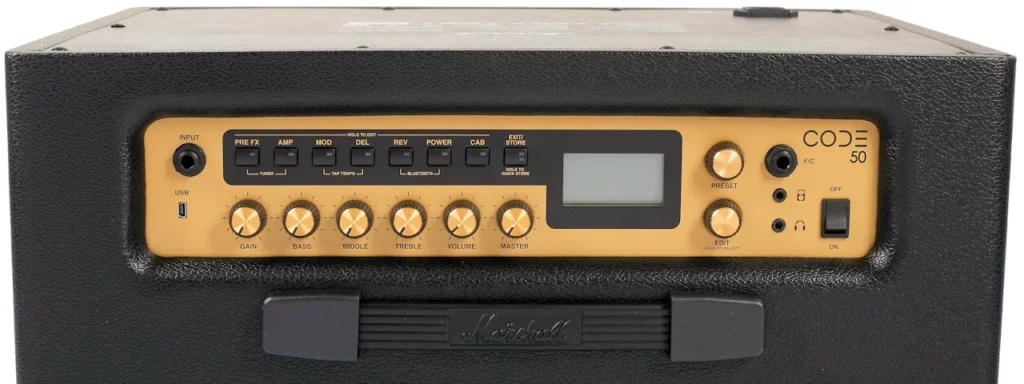
Marshall’s amplifiers CODE series is known for being a range of digitally modeled amplifiers that offer a wide range of tones and sounds. Through modeling, the CODE series is able to mimic a variety of different amps, speakers, and effects, making them very versatile tools for guitarists who want access to a wide range of sounds without having to carry multiple equipment. Listed below are some of the general features of the CODE series, with a focus on the CODE 50 combo amp as an example.
General features:
- Model: Marshall CODE 50
- Type: Digital Modeling Amplifier
Electronic Specifications:
- Power Output: 50 watt
- Presets: 100 fully programmable presets
- Amplifier Models: 14 MST preamp models, 4 MST power amplifier models, and 8 MST speaker models
- Effects: 24 professional effects, including: Compressor, Distortions, Auto Wah, Pitch Shifter, Chorus, Phaser, Flanger and Tremolo, among others.
- Inputs: 1 x 1/4″ jack (instrument), 1 x 1/8″ (aux in)
- Outputs: 1 x 1/8″ (headphones)
- USB Connection: Yes
- Bluetooth: Yes (for music streaming and app control)
- Controls: Gain, Bass, Middle, Treble, Volume, Pre FX, Amp, Mod, Del, Rev, Power, Cab; Plus rotary control for preset selection, memory, tap tempo and tuner.
Physical Characteristics:
- Type: Combo
- Speakers: 1 x 12″
- Weight: Approx. 13 kg
- Dimensions: Approx. 530mm x 440mm x 280mm
Sound Features:
- Sound: Extremely versatile, with the ability to shape a wide range of sounds from Marshall amps and speakers and more.
- Genres: Suitable for all genres, thanks to its wide range of modeled sounds and effects
Note:
- Marshall’s amplifiers CODE series uses Marshall Softube Technology (MST) to create a wide variety of tones.
- The Marshall Gateway app allows you to control the amplifier remotely via Bluetooth, creating and managing sounds, effects and presets with a mobile device.
- The CODE 50 is compact and lightweight enough to be portable, while still offering surprisingly high volume and rich sound.
Marshall’s amplifiers CODE series offers a complete solution for guitarists who want a wide range of tones at their fingertips without the need for additional equipment. It offers a large amount of presets, amp models, and effects in a single compact unit, making it suitable for both home use and live performances.
Studio Series
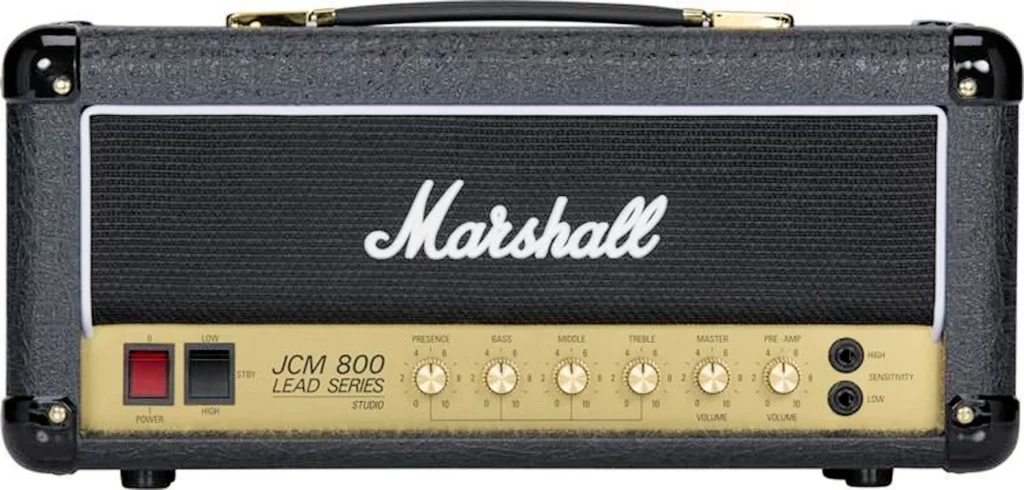
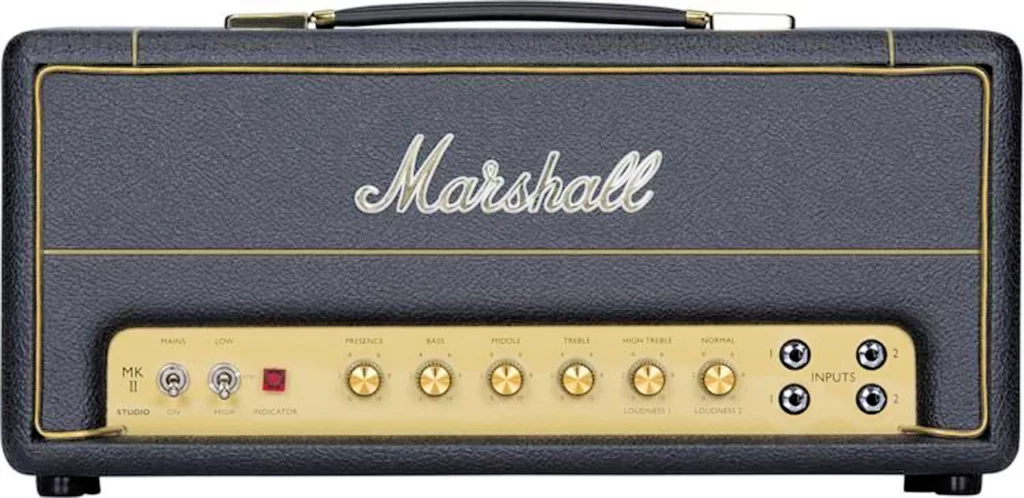
Marshall’s amplifiers “Studio Series” includes several amplifiers that are scaled-down, low-power versions of some of Marshall’s most iconic models. They are designed to deliver Marshall’s classic sound at more manageable volumes, making them ideal for use in the studio and home practice. Among the notable models in the series are the “Studio Classic” and the “Studio Vintage”.
Here are some key features of the two models mentioned:
Studio Classic (BASED ON JCM800 2203)
- Power: 20 Watts, reducible to 5 Watts
- Tubes: 2 x ECC83 (preamp), 1 x ECC83 (phase splitter), 2x EL34 (power)
- Channels: Single channel
- Controls: Presence, Bass, Middle, Treble, Master Volume, Preamp Volume
- Connectors: High and low sensitivity inputs
- Speaker Outputs: 3 x 1/4″ jack (selectable for 16 Ohm or 4 Ohm)
- Dimensions and Weight: Varies between the combo model and the head
- Effects: None
Studio Vintage (BASED ON JMP 1959SLP)
- Power: 20 Watts, reducible to 5 Watts
- Tubes: 2 x ECC83 (preamp), 1 x ECC83 (phase splitter), 2x EL34 (power)
- Channels: 4 selectable inputs, with “jumpering” option
- Controls: Presence, Bass, Middle, Treble, High Treble/Loudness I, Normal/Loudness II
- Connectors: 4 x Input (2 x High, 2 x Low)
- Speaker Outputs: 3 x 1/4″ jack (selectable for 16 Ohm or 4 Ohm)
- Dimensions and Weight: Varies between the combo model and the head
- Effects: None
Common features:
- Construction: Both models are available in combo or header formats. Combo models are equipped with 10″ Celestion V-Type speakers.
- Versatility: Both are designed to be used in various situations, including practice sessions, studio recordings and small gigs.
- Sound: Both offer classic Marshall tone, with the Studio Classic providing the gritty, aggressive tone of the JCM800 and the Studio Vintage offering the crunch and clarity of classic Plexi.
The Studio Series is praised for delivering iconic Marshall amplifiers tones at more manageable volumes, while maintaining the same tones and dynamics as their louder equivalents. They are ideal for guitarists looking for the classic Marshall amplifiers sound without the excessive volume of the originals.
Origin Series
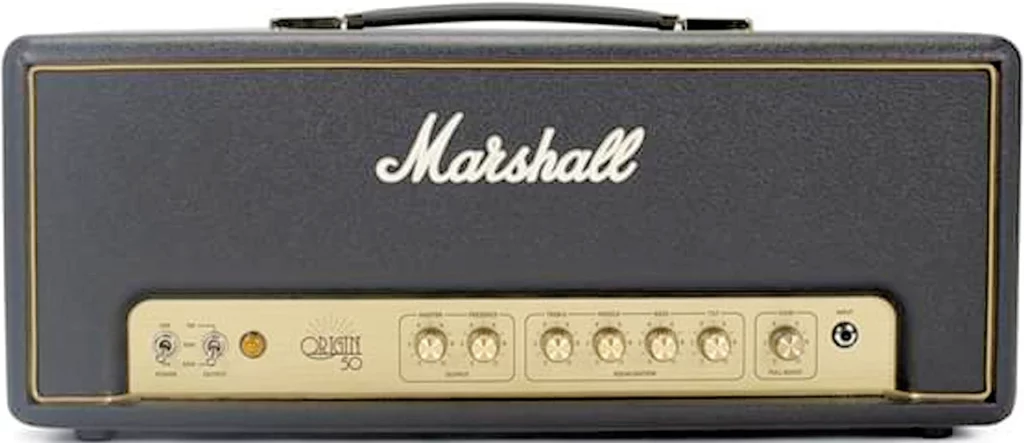
Marshall’s amplifiers “Origin” series is designed to capture the essence of Marshall’s vintage tones, while offering some modern conveniences. Origin Series amplifiers are known for their clean, clearly defined sound, with the ability to achieve a beautiful crunch when pushed.
Here are some general features of the Origin series, taking a popular model, the Origin 50H (tested), as an example. Note that the Origin series includes various models with different powers and configurations, and specifications may vary slightly between different models.
Marshall Origin 50H (head)
- Power: 50 Watts, with power attenuation options (Powerstem: high, medium, low)
- Tubes:
- Preamp: 3 x ECC83
- Power: 2 x EL34
- Channels: 1 (with pull boost)
- Controls: Gain, Tilt (controls the balance between bright and normal tones), Bass, Middle, Treble, Master Volume, Presence
- Effects: None
- Inputs: 1
- Outputs: 4, 8 and 16 Ohm speaker outputs
- Loop Effects: Yes, with send/return controls
- Footswitch: Yes, to activate/deactivate boost mode and loop effects
- Dimensions: Approx. 570 x 240 x 510 mm
- Weight: Approximately 12.7kg
Common features across the Origin series:
- Aesthetics: Vintage look with vinyl frame and classic canvas grille.
- Sound: Clean and crystalline tonal, with natural overdrive capability.
- Versatility: Designed to be used with various pedals and external effects.
- Tilt Control: A unique control that balances bright and normal tones, allowing you to mix between a crisper and warmer sound without changing the channel.
- Pull Boost : Adds additional gain to the sound when needed.
- FX Loop: It allows you to easily insert external effects into the signal chain.
These amps were designed for guitarists who love vintage tone and style. The goal of the Origin series is to provide guitarists with an amplifier that not only sounds good on its own but also works great with a range of pedals, thus allowing users to shape their sound to their specific needs.
Silver Jubilee (1987)
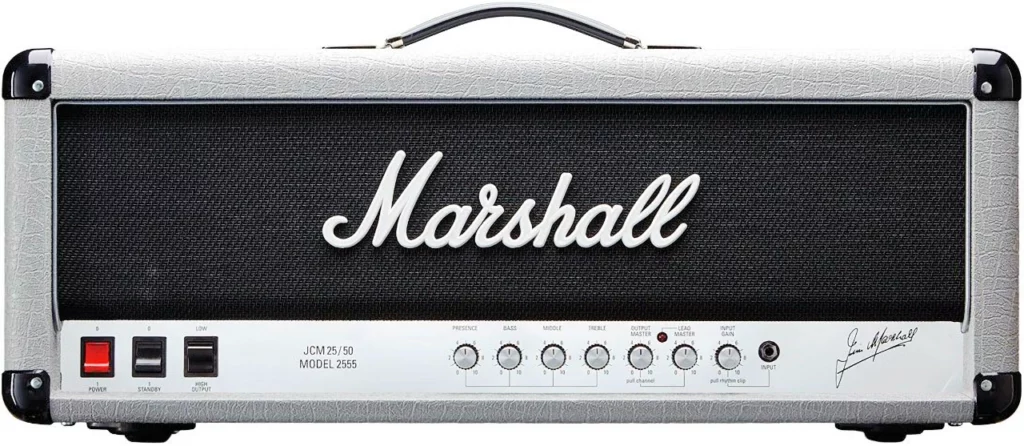
Marshall’s Silver Jubilee is an iconic amplifier, originally released in 1987 to celebrate the company’s 25th anniversary and founder, Jim Marshall’s, 50th anniversary in the music industry. Following the amp’s popularity, Marshall reintroduced the Silver Jubilee model, with the 2555X model closely emulating the original 2555.
Marshall 2555X Silver Jubilee Reissue
Technical specifications:
- Power : 100 Watts
- Tubes:
- Preamp: 3 x ECC83
- Power: 4 x EL34
- Channels: 2 (Clean/Rhythm, Lead)
- Controls:
- Front Panel: Input, Lead Master Volume, Output Master Volume, Treble, Middle, Bass, Presence, Pentode/Triode Switch
- Back Panel: Footswitch Jack, Send/Return Loop Level, Send/Return Loop Jacks, Speaker Outputs, Impedance Selector
- Input: 1
- Outputs: 2 (with impedance selector options for 4/8/16 ohm configurations)
- Effects: None
- Loop Effects: Yes
- Footswitch: Yes
- Dimensions: 750 x 310 x 210 mm
- Weight: 20.5 kg
Sound Characteristics:
- Clean Channel: It offers a clear, clean tone, with ample headroom and a clear response to dynamics.
- Lead Channel: It produces a lush, sustained overdrive that can go from moderate crunch tones to high-gain distortion.
Design Features:
- Color: Silver/Black
- Front Panel: Brushed stainless steel, with a distinctive silver-grey grille.
Note:
- Channel Switching: The 2555X allows you to switch between the clean/rhythm channel and the lead channel using a footswitch.
- Pentode/Triode Switch: Allows you to reduce the amplifier power to 50 Watts for situations where the full 100 Watts are not needed.
- Usage: Suitable for a wide variety of genres thanks to its versatility in clean and distorted tones.
The Marshall Silver Jubilee 2555X is known for its ability to produce both clean and high distortion tones, making it a very versatile and popular amplifier both in the studio and live. Guitarists of various genres, from rock to blues, have used Silver Jubilee series amplifiers to achieve their unique sound.
There are also other models within the Silver Jubilee line, including the 2558 combo and lower-powered models like the 2525H (head) and 2525C (combo), which offer similar tones in different sizes and configurations.
Curiosity and cultural impact of Marshall amplifiers:
- The Logo: The white script logo on a black background has become an unmistakable icon in the world of music.
- Guinness World Record: Marshall amplifiers holds the Guinness World Record for the world’s largest amplifier, unveiled at Wembley in 1998.
- Film Use : Marshall amplifiers are often used in films and music documentaries, symbolizing rock and roll as a whole.
- Mourning in the music world : Upon Jim Marshall’s death in 2012, numerous artists around the world paid tribute, highlighting his company’s enormous impact on modern music.
Are electric guitar amplifiers interesting to you too? All you have to do is take a look at the dedicated section of the site.

 it_IT
it_IT